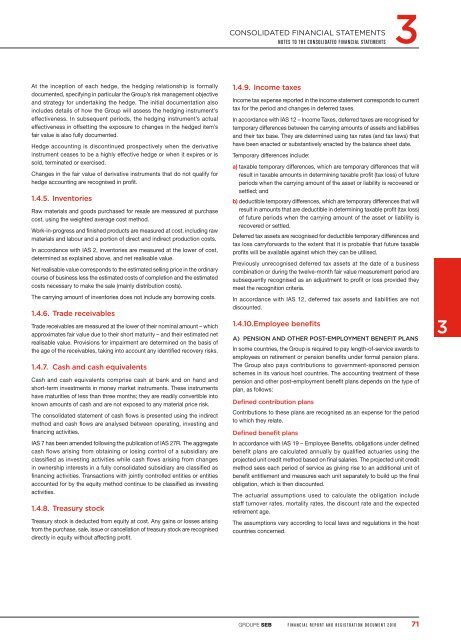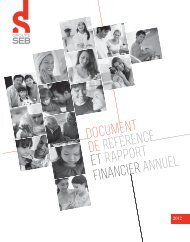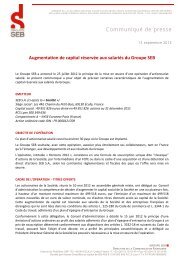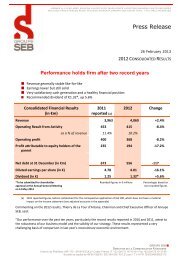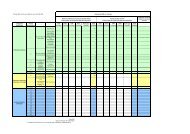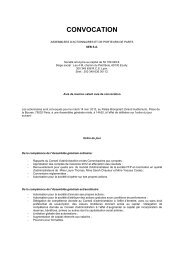Financial Report and Registration Document 2010 - Groupe Seb
Financial Report and Registration Document 2010 - Groupe Seb
Financial Report and Registration Document 2010 - Groupe Seb
Create successful ePaper yourself
Turn your PDF publications into a flip-book with our unique Google optimized e-Paper software.
3<br />
CONSOLIDATED FINANCIAL STATEMENTS<br />
NOTES TO THE CONSOLIDATED FINANCIAL STATEMENTS<br />
At the inception of each hedge, the hedging relationship is formally<br />
documented, specifying in particular the Group’s risk management objective<br />
<strong>and</strong> strategy for undertaking the hedge. The initial documentation also<br />
includes details of how the Group will assess the hedging instrument’s<br />
effectiveness. In subsequent periods, the hedging instrument’s actual<br />
effectiveness in offsetting the exposure to changes in the hedged item’s<br />
fair value is also fully documented.<br />
Hedge accounting is discontinued prospectively when the derivative<br />
instrument ceases to be a highly effective hedge or when it expires or is<br />
sold, terminated or exercised.<br />
Changes in the fair value of derivative instruments that do not qualify for<br />
hedge accounting are recognised in profit.<br />
1.4.5. Inventories<br />
Raw materials <strong>and</strong> goods purchased for resale are measured at purchase<br />
cost, using the weighted average cost method.<br />
Work-in-progress <strong>and</strong> finished products are measured at cost, including raw<br />
materials <strong>and</strong> labour <strong>and</strong> a portion of direct <strong>and</strong> indirect production costs.<br />
In accordance with IAS 2, inventories are measured at the lower of cost,<br />
determined as explained above, <strong>and</strong> net realisable value.<br />
Net realisable value corresponds to the estimated selling price in the ordinary<br />
course of business less the estimated costs of completion <strong>and</strong> the estimated<br />
costs necessary to make the sale (mainly distribution costs).<br />
The carrying amount of inventories does not include any borrowing costs.<br />
1.4.6. Trade receivables<br />
Trade receivables are measured at the lower of their nominal amount – which<br />
approximates fair value due to their short maturity – <strong>and</strong> their estimated net<br />
realisable value. Provisions for impairment are determined on the basis of<br />
the age of the receivables, taking into account any identified recovery risks.<br />
1.4.7. Cash <strong>and</strong> cash equivalents<br />
Cash <strong>and</strong> cash equivalents comprise cash at bank <strong>and</strong> on h<strong>and</strong> <strong>and</strong><br />
short-term investments in money market instruments. These instruments<br />
have maturities of less than three months; they are readily convertible into<br />
known amounts of cash <strong>and</strong> are not exposed to any material price risk.<br />
The consolidated statement of cash flows is presented using the indirect<br />
method <strong>and</strong> cash fl ows are analysed between operating, investing <strong>and</strong><br />
financing activities.<br />
IAS 7 has been amended following the publication of IAS 27R. The aggregate<br />
cash flows arising from obtaining or losing control of a subsidiary are<br />
classifi ed as investing activities while cash fl ows arising from changes<br />
in ownership interests in a fully consolidated subsidiary are classifi ed as<br />
financing activities. Transactions with jointly controlled entities or entities<br />
accounted for by the equity method continue to be classified as investing<br />
activities.<br />
1.4.8. Treasury stock<br />
Treasury stock is deducted from equity at cost. Any gains or losses arising<br />
from the purchase, sale, issue or cancellation of treasury stock are recognised<br />
directly in equity without affecting profit.<br />
1.4.9. Income taxes<br />
Income tax expense reported in the income statement corresponds to current<br />
tax for the period <strong>and</strong> changes in deferred taxes.<br />
In accordance with IAS 12 – Income Taxes, deferred taxes are recognised for<br />
temporary differences between the carrying amounts of assets <strong>and</strong> liabilities<br />
<strong>and</strong> their tax base. They are determined using tax rates (<strong>and</strong> tax laws) that<br />
have been enacted or substantively enacted by the balance sheet date.<br />
Temporary differences include:<br />
a) taxable temporary differences, which are temporary differences that will<br />
result in taxable amounts in determining taxable profit (tax loss) of future<br />
periods when the carrying amount of the asset or liability is recovered or<br />
settled; <strong>and</strong><br />
b) deductible temporary differences, which are temporary differences that will<br />
result in amounts that are deductible in determining taxable profit (tax loss)<br />
of future periods when the carrying amount of the asset or liability is<br />
recovered or settled.<br />
Deferred tax assets are recognised for deductible temporary differences <strong>and</strong><br />
tax loss carryforwards to the extent that it is probable that future taxable<br />
profits will be available against which they can be utilised.<br />
Previously unrecognised deferred tax assets at the date of a business<br />
combination or during the twelve-month fair value measurement period are<br />
subsequently recognised as an adjustment to profit or loss provided they<br />
meet the recognition criteria.<br />
In accordance with IAS 12, deferred tax assets <strong>and</strong> liabilities are not<br />
discounted.<br />
1.4.10. Employee benefits<br />
A) PENSION AND OTHER POST-EMPLOYMENT BENEFIT PLANS<br />
In some countries, the Group is required to pay length-of-service awards to<br />
employees on retirement or pension benefits under formal pension plans.<br />
The Group also pays contributions to government-sponsored pension<br />
schemes in its various host countries. The accounting treatment of these<br />
pension <strong>and</strong> other post-employment benefit plans depends on the type of<br />
plan, as follows:<br />
Defined contribution plans<br />
Contributions to these plans are recognised as an expense for the period<br />
to which they relate.<br />
Defined benefit plans<br />
In accordance with IAS 19 – Employee Benefits, obligations under defined<br />
benefit plans are calculated annually by qualified actuaries using the<br />
projected unit credit method based on final salaries. The projected unit credit<br />
method sees each period of service as giving rise to an additional unit of<br />
benefit entitlement <strong>and</strong> measures each unit separately to build up the final<br />
obligation, which is then discounted.<br />
The actuarial assumptions used to calculate the obligation include<br />
staff turnover rates, mortality rates, the discount rate <strong>and</strong> the expected<br />
retirement age.<br />
The assumptions vary according to local laws <strong>and</strong> regulations in the host<br />
countries concerned.<br />
3<br />
GROUPE SEB<br />
FINANCIAL REPORT AND REGISTRATION DOCUMENT <strong>2010</strong><br />
71


